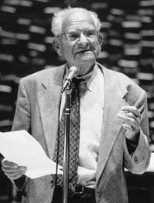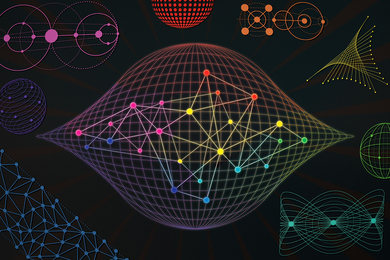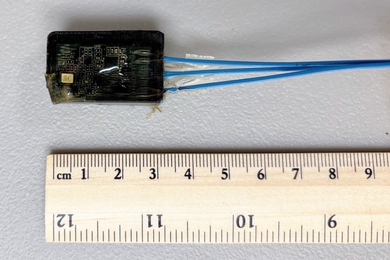CAMBRIDGE, Mass. -- MIT Institute Professor Emeritus Victor F. Weisskopf, a prot�g� of physicist Niels Bohr who helped develop the atomic bomb and later became an outspoken advocate of arms control, died Sunday night at his home in Newton, Mass. He was 93 years old.
Professor Weisskopf -- called "Viki" by all who knew him -- was noted for his theoretical work in quantum electrodynamics, the structure of the atomic nucleus, and elementary particle physics. But beyond his purely scientific accomplishments, he played a leading role in explaining science -- and its role in society -- to the public. In the years since his work on the Manhattan Project in World War II, he warned repeatedly of the growing danger of nuclear war.
"Viki was a giant of 20th-century physics, a great spokesman for peace, for the welfare of humanity, and the beauty of physics," said professor Robert L. Jaffe, director of the MIT Center for Theoretical Physics. "He was a friend to everyone who knew him. His influence here at MIT and in the Center for Theoretical Physics was beneficent and profound. His perpetual curiosity and his enthusiasm for new ideas and young people defined MIT's style of doing physics. We will miss him."
Dr. Weisskopf was director-general from 1961 to 1965 of the European Center for Nuclear Research (CERN) in Geneva, Switzerland, heading an international research establishment that operated the world's second most powerful large particle accelerator, or "atom smasher," just as it started to be used for research. Under his direction, CERN developed into one of the foremost institutions in this. On his return to MIT from CERN in 1966, he was given the rank of Institute Professor, an honor bestowed by MIT in recognition of faculty members of great distinction. From 1967 to 1973, Dr. Weisskopf was head of the Department of Physics, where he was a major force in the development of physics research -- both through the many students he taught and through the research group which he built up to become the present Center for Theoretical Physics.
Additional recognition from the MIT faculty came in 1973 when he was named the James R. Killian Award Lecturer.
Dr. Weisskopf formally retired from MIT on July 30, 1974, after 28 years at the Institute, but he remained active as senior lecturer in physics. In October, 1974, a large number of the world's leading scientists, including six Nobel laureates, gathered at MIT for a two-day symposium convened specifically in celebration of Dr. Weisskopf and his contributions to science and society.
A naturalized United States citizen since 1943, Dr. Weisskopf was born in Vienna, Austria, on Sept. 19, 1908. He received a PhD degree from the University of Gottingen, Germany, in 1931, and served as research associate at the University of Copenhagen from 1932 to 1933 and the Institute of Technology in Zurich from 1934 to 1936.
Bohr, the Nobel Prize-winning Danish physicist and founder of quantum mechanics, was Dr. Weisskopf's mentor during their time together in Copenhagen. While in Denmark, he met his first wife, ballet dancer Ellen Tvede, who died in 1989.
Dr. Weisskopf once told an interviewer that he had come out of the "golden age" of physics, when European scientists in the 1920s and '30s created a new picture of how the world behaved at the atomic level.
"We touched the nerve of the universe," he said. "It was a great revolution that allowed us for the first time in the history of science to get at the root of the matter -- why are leaves green, why are metals hard, why are the mountains so high and not higher -- all those natural questions of our immediate environment got an answer."
Dr. Weisskopf made major contributions to that work, say those who knew him, by seeing through the mathematics to the principles beneath.
"Viki is a past master at taking subtle and mathematical and opaque material, and by careful thought, reformulating it into a simple, clear problem," said physicist Philip Morrison, Dr. Weisskopf's colleague at MIT.
In 1937, just before the Nazis took over Austria, Dr. Weisskopf came to the United States to the University of Rochester, where he served as instructor and then assistant professor.
In 1943, he joined the Manhattan Project at Los Alamos, N.M., where he worked on the atom bomb project as a group leader and associate head of the theory division on the exploitation of nuclear energy.
In 1944 he was one of many physicists who participated in the founding of the Federation of Atomic Scientists. Its purpose was mainly two-fold: to warn the public of the consequences of atomic war -- thus hoping for the creation of an international agreement against the use of atomic weapons -- and to support the peaceful use of atomic energy.
In 1945 he was appointed associate professor of physics at MIT but was granted a leave of absence to complete his work at Los Alamos. In 1946 he came to the Institute as a full professor, and later was in charge of the theory group in MIT's Laboratory for Nuclear Science, where he and his group made important contributions to theories of nuclear reactions and quantum electrodynamics. Together with John M. Blatt, he wrote a textbook, Theoretical Nuclear Physics, probably the most-used book in that subject.
In 1949 Dr. Weisskopf became a member of the emergency committee of scientists whose president was Albert Einstein. This committee fought for control of atomic weapons and for an understanding between the countries of the East and West concerning atomic armaments. He participated in a manifesto against the hydrogen bomb in 1950 and in a campaign for the exchange of scientists by the U.S. and the rest of the world.
He spent increasing amounts of time in the years following his retirement in attempting to raise public awareness of the dangers of nuclear weapons, weapons he had helped to create.
In a 1983 interview, he termed the nuclear bomb "a shadow over my life." In an address that same year to a reunion of scientists who had worked to develop the atomic bomb, he described that effort as "the most exciting years of our lives." But he added, "our achievement has been the unintended cause of the world's most tragic predicament. Therefore, we physicists have a special duty." Another time he commented, "There is such fantastic beauty, in landscape, poetry, painting, and now these are all threatened."
While immersing himself in the issue of arms control, Dr. Weisskopf also said that "political questions take a lot of nervous energy" and that he always returned to physics for relaxation. "When life is very bad," he told an interviewer, "two things make life worth living -- Mozart and quantum mechanics."
In another expression of his philosophy, when he was profiled on the "Nova" public television series in 1984, he likened the "big bang" theory of the universe to a work by Haydn and suggested that Haydn's music is in its own way as descriptive of the "big bang" as are the words of physicists. "I do not believe in the supernatural," he said, but he insisted that there is "something divine in our lives."
While he was at CERN, Dr. Weisskopf's numerous awards were augmented with the conferral of an honorary Ph.D degree from the University of Vienna on the 600th anniversary of that institution. He received numerous other honorary degrees from institutions throughout the world, including Brandeis University, Harvard University, Notre Dame, Oxford University Rockefeller University Yale University and the Weizman Institute.
His book "Knowledge and Wonder: The Natural World as Man Knows It" also was published (Doubleday & Co., New York, 1962) while he was in Geneva. It was selected by the Thomas Alva Edison Foundation as the best science book of the year for youth. Some of his essays are collected in the book, "Physics in the XX Century," published by the MIT Press. His own series of essays, "The Privilege of Being a Physicist," was published in 1989 (W.H. Freeman & Co., New York). He co-authored a two-volume book, "Concepts of Particle Physics," with MIT Ph.D Kurt Gottfried, a theoretical physicist at Cornell University.
In 1991, Dr. Weisskopf wrote "The Joy of Insight," a personal memoir published by Basic Books as part of series of autobiographies and biographies of contemporary scientists sponsored by the Alfred P. Sloan Foundation.
On his departure from CERN , his international colleagues collaborated in publishing a volume of 39 essays dedicated to Dr. Weisskopf. The volume's preface said in part: "It is Weisskopf's unique achievement that he has carried over the devoted idealism and the enthusiasm of his early days into a new world of organized research and large-scale experimentation. Through the work he did at CERN, through the impact of his mature personality, he has had a profound influence on modern physics in Europe."
Dr. Weisskopf's international honors included the Max Planck Medal of the German Physical Society in 1956, the Boris Pregal Medal of the New York Academy of Sciences in 1970, the Prix Mondial Cino de Duca (France) for humanism in science in 1972, the Order pour le Merite (German) in 1978, the Smolukowski Medal of the Polish Physical Society in 1979, the national Medal of Science (US) in 1980 and the Wolf Prize in Physics (Israel) in 1981,the J. Robert Oppenheimer Medal in 1983, the 1988 Enrico Fermi Award of the U.S. Department of Energy, the Ludwig Wittgenstein Prize of the Austrian Research Organization in 1990, and the 1991 Public Welfare Medal of the U.S. National Academy of Sciences.
Dr. Weisskopf was a member of the National Academy of Sciences and the Federation of American Scientists. He was a fellow of the American Physical Society and its president in 1960-61, and he was president of the American Academy of Arts and Sciences from 1976 to 1979.
He was on the board of editors of Nuclear Physics and Annals of Physics and he authored numerous articles and papers on nuclear physics, quantum theory, and radiation theory.
In December, 1975, he was named by Pope Paul VI to the 70-member Pontifical Academy of Sciences which honored "pure science wherever it is found." He served as chairman of the High Energy Physics Advisory Panel of the former Atomic Energy Commission and was a corresponding member of the academies of science of Austria, Bavaria, Denmark, France, Scotland and Spain.
Dr. Weisskopf is survived by his wife, Duschka (Scott), former director of the Jackson Homestead in Newton; a daughter, Karen Worth, who works in the Boston school system; a son,Thomas E., a professor of economics at the University of Michigan; and five grandchildren. Burial will be at the family's summer home in France.






